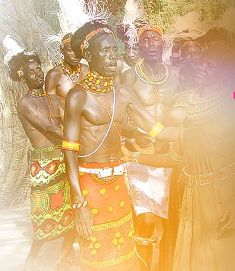By Iminza Keboge
Published November 28, 2019
 He may have been a highly regarded artist on the international scene. However, at home, from where he derived his inspiration and practised, he was virtually unacknowledged.
He may have been a highly regarded artist on the international scene. However, at home, from where he derived his inspiration and practised, he was virtually unacknowledged.
Consequently, an organisation called Art in Tanzania organised an art exhibition at Alliance Francaise in Dar es Salaam, Tanzania’s commercial capital, “to pay in his lifetime a modest tribute to the most renowned Tanzanian artist.”
RELATED: Why African Artists Would Rather Be Illegal Immigrants in the West
“What we want to do,” wrote Yves Goscinny, “is is to show the public in general and the school children of Tanzania in particular, a comprehensive display of a great Tanzanian artist’s creativity that ultimately took him to the world art scene.”
A glossy, 106-page, full colour coffee table book titled Tribute to George Lilanga, accompanied that exhibition that took place September 18 – October 6, 2001, some four years prior to the demise of the artist who had been honoured with a solo exhibition of his recent paintings and sculptures.
RELATED: Do You Require A Visa to Visit Kenya?
 Thanks to Goscinny and Art in Tanzania for the publication, many more people continue to interact with the work of Lilanga 14 years later after his death who in June 2005.
Thanks to Goscinny and Art in Tanzania for the publication, many more people continue to interact with the work of Lilanga 14 years later after his death who in June 2005.
Tribute to George Lilanga is divided into five sections, each dedicated to a different subject matter.
RELATED: 17 Questions for 17-Year-Old Music Sensation
The Introduction, written in English with French and Kiswahili, contains the biography of Lilanga, complete with detailed information about his art of self representation called Shetani. Each of the remaining four sections carry captioned samples of the late Lilanga’s paintings, etchings, sculptures and the resume of the artist.
RELATED: African Arts-Related Calls & Announcements
 “The imaginary world of George Lilanga is inhabited by a multitude of cartoon-like personages, not very different from people,” writes Goscinny, the director of Art in Tanzania. “Lilanga’s cosmos is rather the world of spirits, or ‘mizimu’ in Kiswahili, meaning all the presences filling one’s mind, whether they are deceased or living people … you are thinking of, or ideas, feelings, passions, phantasms that are obsessing you.”
“The imaginary world of George Lilanga is inhabited by a multitude of cartoon-like personages, not very different from people,” writes Goscinny, the director of Art in Tanzania. “Lilanga’s cosmos is rather the world of spirits, or ‘mizimu’ in Kiswahili, meaning all the presences filling one’s mind, whether they are deceased or living people … you are thinking of, or ideas, feelings, passions, phantasms that are obsessing you.”
Though Lilanga’s people have only “two fingers on their hands, three toes on their feet, extended lips that might remind one of the traditional Ndonya Makonde women ,” Goscinny contends that it is wrong to refer to them as ‘mashetani’ as the term implies a bad connotation.
RELATED: The Sin of Being Left-Handed in the World of the Right-Handed
Far from it, Goscinny says “Lilanga’s aliens are funny-looking rather than horrifying and they are also depicted while having fun among themselves, in common scenes of daily life in Tanzania.”
 That was the world of George Lilanga, a Makonde artist who spoke only Kimakonde and Kiswahili despite having visited and exhibited his work in many non-Kimakone and non-Kiswahili-speaking countries such as US America, Germany, France, Japan, Italy, Britain, South Africa, Botswana, Austria, Senegal and India.
That was the world of George Lilanga, a Makonde artist who spoke only Kimakonde and Kiswahili despite having visited and exhibited his work in many non-Kimakone and non-Kiswahili-speaking countries such as US America, Germany, France, Japan, Italy, Britain, South Africa, Botswana, Austria, Senegal and India.
RELATED: Use Nollywood Filmmaking Model to Boost Economy
Hey, don’t be content to just hear our story. Go for this book. Read this book. Enjoy the paintings. Feed on the sculptures. Learn from the etchings. Appreciate the work of the artist who, despite being Tanzania’s best known ambassador of creativity, was largely ignored at home but feted abroad.




